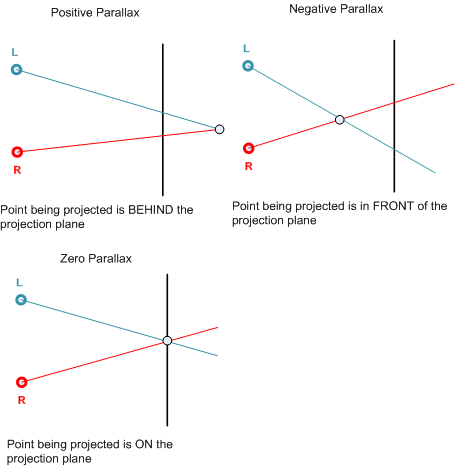Parallax
Parallax is created by defining two cameras corresponding to the left and right eyes separated by some distance (called interocular distance or simply eye-separation) and having a plane at a certain depth along the viewing direction (called convergence distance) at which the parallax is zero.
Objects at the convergence depth will appear to be at the same depth, ON the screen. Objects closer to the camera than the convergence distance will seem to be in FRONT of screen, and objects further in depth than the convergence distance will appear BEHIND the screen.
| BEHIND | The projection for the left eye is on the left and the projection for the right eye is on the right. The distance between the left and right eye projections is called the horizontal parallax. Since the projections are on the same side as the respective eyes, it is called a POSITIVE parallax. Note that the maximum positive parallax occurs when the object is at infinity. At this point the horizontal parallax is equal to the interocular distance. |
| FRONT | If an object is located in front of the projection plane, then the projection for the left eye is on the right and the projection for the right eye is on the left. This is known as NEGATIVE horizontal parallax. Note that a negative horizontal parallax equal to the interocular distance occurs when the object is half way between the projection plane and the centre of the eyes. As the object moves closer to the viewer the negative horizontal parallax increases to infinity. |
| MIDDLE | If an object lies at the projection plane then its projection onto the focal plane is coincident for both the left and right eye, hence ZERO parallax. |
